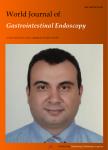Endoscopic ultrasound guided interventional procedures
Endoscopic ultrasound guided interventional procedures作者机构:Department of Gastroenterology Postgraduate Institute of Medical Education and Research
出 版 物:《World Journal of Gastrointestinal Endoscopy》 (世界胃肠内镜杂志(英文版)(电子版))
年 卷 期:2015年第7卷第6期
页 面:628-642页
学科分类:1002[医学-临床医学] 100201[医学-内科学(含:心血管病、血液病、呼吸系病、消化系病、内分泌与代谢病、肾病、风湿病、传染病)] 10[医学]
主 题:Endosonography Pancreatic pseudocyst Celiac plexus Choledochostomy Cholecystostomy Photochemotherapy Abdominal abscess Common bileduct Pancreatic duct Endoscopic ultrasound-guidedfine needle aspiration
摘 要:Endoscopic ultrasound(EUS) has emerged as an important diagnostic and therapeutic modality in the field of gastrointestinal endoscopy. EUS provides access to many organs and lesions which are in proximity to the gastrointestinal tract and thus giving an opportunity to target them for therapeutic and diagnostic purposes. This modality also provides a real time opportunityto target the required area while avoiding adjacent vascular and other structures. Therapeutic EUS has found role in management of pancreatic fluid collections, biliary and pancreatic duct drainage in cases of failed endoscopic retrograde cholangiopancreatography, drainage of gallbladder, celiac plexus neurolysis/blockage, drainage of mediastinal and intra-abdominal abscesses and collections and in targeted cancer chemotherapy and radiotherapy. Infact, therapeutic EUS has emerged as the therapy of choice for management of pancreatic pseudocysts and recent innovations like fully covered removable metallic stents have improved results in patients with organised necrosis. Similarly, EUS guided drainage of biliary tract and pancreatic duct helps drainage of these systems in patients with failed cannulation, inaccessible papilla as with duodenal/gastric obstruction or surgically altered anatomy. EUS guided gall bladder drainage is a useful emergent procedure in patients with acute cholecystitis who are not fit for surgery. EUS guided celiac plexus neurolysis and blockage is more effective and less morbid vis-à-vis the percutaneous technique. The field of interventional EUS is rapidly advancing and many more interventions are being continuously added. This review focuses on the current status of evidence vis-à-vis the established indications of therapeutic EUS.



